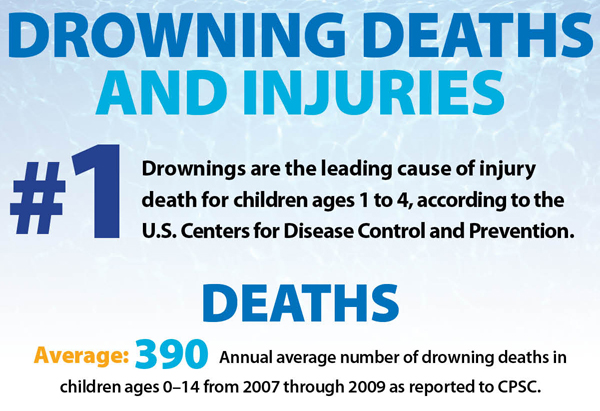Pool Safely's First Splash Event to Focus on Vulnerable Populations
Children younger than 5 represent nearly 75% of pool and spa deaths, latest data show. African-American, Hispanic children at high risk.

This year, Pool Safely's focus is on populations most at risk of drowning, including children younger than 5 years old who represent nearly 75 percent of child drowning fatalities and African American and Hispanic children between the ages of 5 and 14 who drown at higher rates than white children, according to the Centers for Disease Control and Prevention.
Data from USA Swimming indicates that 70 percent of African American children and 62 percent of Hispanic children cannot swim, making them especially vulnerable populations.
"CPSC's Pool Safely campaign has worked to prevent countless drownings, and we will continue to work to save even more lives this year," said Chairman Inez Tenenbaum. "Drowning is still the leading cause of unintentional deaths with children younger than 5. That's why the Pool Safely campaign is encouraging all parents and caregivers of children, especially African American and Hispanic children, to help them learn to swim and to take water safety seriously."
New statistics released by CPSC today include:
- An annual average of 390 pool or spa-related drownings for children younger than 15 occurred from 2007 to 2009; about 75 percent (293) of the reported fatalities involved children younger than five.
- An estimated annual average of 5,200 pool or spa-related emergency department-treated submersion injuries for children younger than 15, from 2009 to 2011; children younger than 5 represented 79 percent, or 4,108, of these injuries.
- Children between the ages of 1 and 3 (12 months through 47 months) represented 66 percent of estimated injuries for 2009 through 2011 and 67 percent of the reported fatalities for 2007 through 2009 involving children younger than 15 years.
- The majority of the estimated emergency department-treated submersion injuries for 2009 through 2011 and the reported fatalities for 2007 through 2009 were associated with pools.
- Approximately 51 percent of the estimated injuries for 2009 through 2011 and 73 percent of the fatalities for 2007 through 2009 involving children younger than 15 years old occurred at a residence.
- Residential locations dominated incidents involving victims younger than 5 years of age (54 percent for injuries and 85 percent for fatalities).
- Approximately 58 percent of fatalities (annual average of 226) occurred in in-ground pools. Portable pools accounted for 10 percent of the reported fatalities (annual average of 40) to children younger than 15 years of age.
- There were no reported entrapment fatalities for 2011. CPSC received seven reports of entrapment injury incidents during 2011.
Today, Chairman Tenenbaum shared simple steps to pool safely and data from CPSC's annual drowning/near-drowning and entrapment reports, at an event at the International Swimming Hall of Fame in Ft. Lauderdale. She was joined by Wanda Butts, a mother who lost her son to drowning in 2006 and formed The Josh Project to help other children learn how to swim; Kim Burgess from the National Drowning Prevention Alliance and the Broward County Health Department's Drowning Prevention Coordinator; and USA Swimming's "Make a Splash" official Kim O'Shea.
"After losing my son, I wanted to do something to help others, so other moms wouldn't have to suffer from the loss of a child drowning," Butts said. "Together, we can make a difference this summer and ensure that our kids pool safely."
"The National Drowning Prevention Alliance has been a partner of the Pool Safely campaign since its inception." Burgess said. "Education is the key to preventing tragic incidents at the pool this summer. We encourage everyone to Pool Safely this holiday weekend and in the months to come."
"The USA Swimming Foundation is proud to lend its research and resources to further the life-saving learn-to-swim message," O'Shea said. "We are incredibly proud to have enrolled more than 1.2 million children in swimming lessons through our Make a Splash initiative, to educate parents and communities across the nation about the importance of learning to swim."
Pool Safely, a national public education campaign, works with partners around the country to reduce child drownings, near-drownings submersions and entrapment incidents in swimming pools and spas. Parents, caregivers, and the media are encouraged to visit PoolSafely.gov or @PoolSafely on Twitter for vital safety information regarding the prevention of child submersions in and around pools and spas.
For the complete reports see: Pool and Spa Submersions 2012 (pdf) and Circulation/Suction Entrapments 2012 (pdf). The years for reported injury and fatality statistics differ due to a lag in fatality reporting.
The Pool Safely campaign is CPSC's public education and information program supporting the requirements of Section 1407 of the Virginia Graeme Baker Pool and Spa Safety Act (P&SS Act), federal legislation signed into law in 2007, mandating new requirements for pool and spa safety.
About the U.S. CPSC
The U.S. Consumer Product Safety Commission (CPSC) is charged with protecting the public from unreasonable risk of injury associated with the use of thousands of types of consumer products. Deaths, injuries, and property damage from consumer product-related incidents cost the nation more than $1 trillion annually. Since the CPSC was established more than 50 years ago, it has worked to ensure the safety of consumer products, which has contributed to a decline in injuries associated with these products.
Federal law prohibits any person from selling products subject to a Commission ordered recall or a voluntary recall undertaken in consultation with the CPSC.
For lifesaving information:
- Visit CPSC.gov.
- Sign up to receive our email alerts.
- Follow us on Facebook, Instagram, X, BlueSky, Threads, LinkedIn and Truth Social.
- Report a dangerous product or a product-related injury on www.SaferProducts.gov.
- Call CPSC’s Hotline at 800-638-2772 (TTY 800-638-8270).
- Contact a media specialist.
Please use the below phone number for all media requests.
Phone: (301) 504-7908
Spanish: (301) 504-7800

